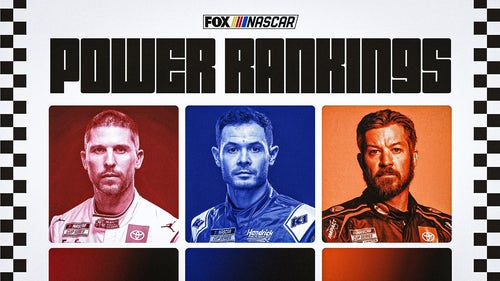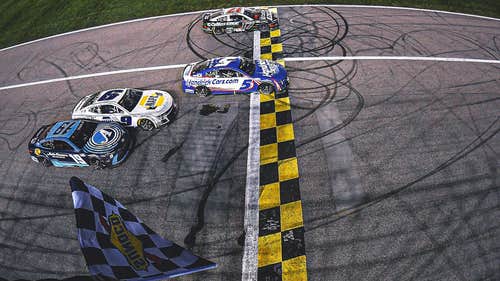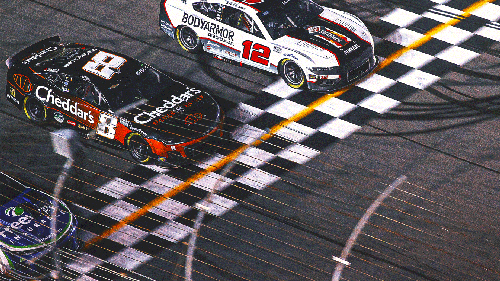
Five Of The Wildest NASCAR Fires From This Decade
Feb 27, 2012; Daytona Beach, FL, USA; A jet drier catches fire after NASCAR Sprint Cup Series driver Juan Pablo Montoya (42) lost control of his car an collided in turn three during the Daytona 500 at Daytona International Speedway. Mandatory Credit: Douglas Jones-US PRESSWIRE
Blown engines and wrecks cause fires regularly in NASCAR races, but occasional off-track fires are the real eye-catchers.
When a sport is powered by 40 cars burning flammable liquids within combustion chambers for hours on end, fire may escape from time to time. In NASCAR, any hope of containing such a volatile mixture inside a cylinder is wishful thinking.
NASCAR fires can be freaky, ferocious and on rare occasion funny, but one thing is for sure — when they take place outside of the context of a blown engine or cars wrecking on track, they grab our attention.
Here are a few oddities from this decade:
October 2011: Talladega Transporter Fire
Regan Smith’s #78 car hauler produced a cloud of black smoke after the Good Sam Club 500 at Talladega.
The fire reportedly started when Smith’s crew removed a fuel probe from a gas can and attempted to empty the gas into a separate container, when a spark caused the ignition. Crews initially scattered, and alert members grabbed fire extinguishers. They managed to contain the fire without injuries or extensive damage.
It was a lucky break, because the garage area is typically swarming with teams and media members after races. Smith’s car was nowhere near the incident because it had been dropped off in another part of the garage after an earlier race incident. This came a year after the team lost a tractor trailer and motorcoach in an accident while driving in icy conditions.
Next: Jet Dryer Explodes At Daytona
Feb 27, 2012; Daytona Beach, FL, USA; NASCAR Sprint Cup Series safety crews work to put out a fire from a jet drier that was hit by driver Juan Pablo Montoya (not pictured) under caution during the Daytona 500 at Daytona International Speedway. The race is being run on Monday for the first time in the 54 year history of the race due to rain. Mandatory Credit: Andrew Weber-USA TODAY Sports
February 2012: Daytona 500 Jet Dryer Fire
NASCAR fans’ jaws collectively dropped when Juan Pablo Montoya smashed a jet dryer under caution, sending a ball of fire into the sky at the Daytona 500. What made it more of a spectacle was the fact that it was a postponed race that ran into the night, a perfect setting for fireworks.
200 gallons of jet fuel spilled onto the track, which crews quickly tried to clean. Before much time passed, though, something sparked and lit the entire pool of fuel running down the track. Flames arose deep into the night air. A lengthy delay ensued, adding even more time to the already heavily delayed race.
Montoya’s reputation may have been damaged, but no one was physically hurt. Some might argue that he saved his reputation after returning to IndyCar and winning a championship.
October 2013: Kansas Bush Fire
It may not hold the cultural and historical relevance of the burning bush Moses encounters in the Bible, but it was enough of a distraction to bring out the caution at Kansas during the Cup race. What initially looked like smoke from an on-track incident proved to be otherwise. Usually, off-track fires come from the inside of the oval but that wasn’t the case here.
According to a track spokesperson, a lit cigarette caused the blaze. The caution wasn’t a long one, and crews working at the track quickly eliminated any safety threats present. In the spirit of the list, however, it deserves a nod for the weird atmosphere it created at the track that day.
The race broke the track record for cautions by one, a statistic for which we can thank the burning bush.
Next: Sprint Unlimited Pace Car Fire
Driver Todd Bodine – Mandatory Credit: Matthew O
February 2014: Pace Car Fire
Coming up to the final 20-lap segment of the Sprint Unlimited, the Brett Bodine-piloted pace car began smoking and went up in flames. In a bizarre turn of events, the ever-present caution car had produced a caution of its own. Bodine took no chances in driving it to the pits.
Later reports showed that the trunk of the Chevy SS caught fire. Chevrolet claimed the blaze was caused by a battery pack used to power a purpose-built auxiliary electrical kit to operate the numerous caution lights during the race.
Naturally, this probably came as a relief to the auto maker, who didn’t need any new recalls advertised on national television.
April 2015: Richmond Pit Road Fire
In one of the scarier fire incidents of recent memory, Brendan Gaughan’s car burst into flames while pitting, intensified by the gas can in use. Two of Gaughan’s crew members and one of Eric McClure’s crew members went to the hospital.
McClure’s crew member, Clifford Turner, was not burned but inhaled fire extinguisher fluid when he was on top of Gaughan’s crew member trying to put out the fire.
The incident was difficult to follow, as flame engulfed an entire pit box, but it started because Gaughan’s fuel man spilled a puddle of gas, which was then sparked, officials presume, by a lug nut from the car.
Turner was treated and released promptly, and in the following days Gaughan’s crew members, Anthony O’Brien and Josh Wittman, were released from the hospital. The fire was caused by a malfunction on the head of the gas can, which prevented the nozzle from sealing fully.
Property-damaging fires may seem to come around only rarely, but events of the last few years prove otherwise. While we can look back and laugh at some, many cause bodily injury and financial burdens for small teams.
More from Beyond the Flag
This article originally appeared on












































































































































